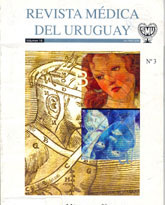Cyclospora cayetanensis in Uruguay
Etiologic agent of the traveller's diarrhoea acquired abroad
Abstract
Cyclospora cayetanensis (Ortega, Gilman, and Sterling, 1994) is the emergent agent of cyclosporiasis, a new acute and self-limited diarrhoeal disease. It lasts from two to six weeks when affects immunocompetent individuals and it causes chronic intermittent diarrhea in AIDS patients. This disease and its etiologic agent have been recently reported in Uruguay, affecting travellers coming from previously known endemic areas. In the present work, the whole number of cases in the country is reported. We conclude that C. cayetanensis is an agent of the traveller's diarrhoea in Uruguay, without occurrence of native cases so far.
References
2) Kovanda JS. Traveler's diarrhea: patogenesis and management. Rev Med Liege 2000; 55(6): 492-99.
3) Olsen W. Parasitología animal. 2a.ed. Barcelona: Argos, 1990.
4) Ortega Y, Sterling C, Gilman R, Cama V, Díaz F. Cyclos-pora species a new protozoan pathogen of humans. N Engl J Med 1993; 328(18): 1308.
5) Ortega Y, Gilman R, Sterling C. A new coccidian parasite (Apicomplexa: Eimeriidae) from humans. J Parasitology 1994; 80(4): 625.
6) Salvatella R, Eirale C, Sundberg F. Primera notificación de Cyclospora cayetanensis en Uruguay, a partir de un caso de diarrea del viajero adquirido en el exterior. Rev Urug Pat Clínica 2000; 32: 9-12.
7) Soave R, Johnson W. Cyclospora: conquest of an emerging pathogen. Lancet 1995; 345(8951): 667.
8) Clarke S, McIntyre M. Human infection with Cyclospora. J Infect Dis 1994; 29(1): 112.
9) Wittner M, Tanowitz H, Weiss L. Parasitic infections in AIDS patients. Infect Dis Clin North Am 1993; 7(3): 569.
10) Mannheimer S, Soave R. Protozoal infections in patients with AIDS. Infect Dis Clin North Am 1994; 8(2): 483.
11) Centers for Disease Control and Prevention (CDC), Division of Parasitic Disease. Identification and Diagnosis of parasites of public health concern. Atlanta: CDC, 2000.
12) Centers for Disease Control and Prevention (CDC), Division of Parasitic Disease. Cyclospora infection. Information for health care providers. Atlanta: CDC, 1999.
13) Herwaldt B, Ackers M, CWG. An outbreak in 1996 of cyclosporiasis associated with imported raspberries. N Engl J Med 1997; 336(22): 1548-56.
14) Centers for Disease Control and Prevention (CDC): Update. Outbreaks of Cyclospora cayetanensis infections. United States and Canada, 1996. MMWR 1996; 45(28): 611.
15) Rabold J, Hoge C, Shlim D, Kefford C, Rajah R, Echeverría P. Cyclospora outbreak associated with chlorinated drinking water. Lancet 1994; 344(8933): 1360.
16) rganización Panamericana de la Salud. El control de las enfermedades transmisibles en el hombre. 17ª ed. Washington: OPS, 2001: 98-9.
17) Instituto C. Malbrán. Coproparasitología. Buenos Aires: Inst C Malbrán: 1993.
18) Eberhard MD. Laboratory diagnosis of Cyclospora infections. Arch Pathol Lab Med 1997; 121: 792-7.
19) Ritchie LS. An Ether Sedimentation Technique for rutine Stool Examination. Bull US Army Med Dept 1948; 8: 326.
20) Salvatella R, Eirale C. Examen coproparasitario. Metodología y empleo. Revisión técnico metodológica Rev Med Uruguay 1996; 12(3): 215-25.
21) Bonifacino R. Diagnóstico de Cryptosporidium sp. Por la técnica de Ziehl Neelsen modificada. Rev Soc Urug Parasitol 1987; 1(1): 7-14.
22) Orlandi PA, Lampel KA. Extraction-Free, Filter-Based Template Preparation for Rapid and Sensitive PCR Detectin of Pathogenic Parasitic Protozoa. J Clin Microbiol 2000; 38(6): 2271-7.
23) Sterling C, Ortega Y. Cyclospora: an enigma worth unraveling. Emerg Infect Dis 1999; 5(1): 1-8.

This work is licensed under a Creative Commons Attribution-NonCommercial 4.0 International License.













